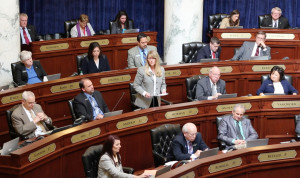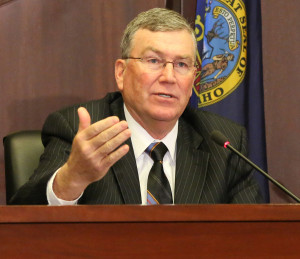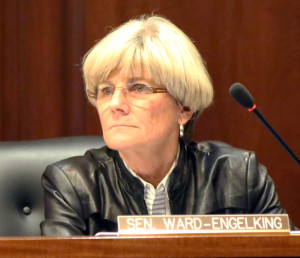Last time around, it took lawsuits to force Idaho to rewrite its school funding formula.
Then it took a ton of new money to seal the deal. The spending increase was huge — and today, it would take more than $350 million to match it.
That was 1994.
Now, fast forward to 2016.
The funding formula rewrite would probably start with a legislative “interim committee,” meeting between the 2016 and 2017 sessions. The Legislature would have to pass a concurrent resolution creating the committee, and that proposal hasn’t been introduced yet. State schools superintendent Sherri Ybarra is expected to take part in the review, along with representatives of the State Board of Education and Gov. Butch Otter’s office.
Key legislators are planning to take a run at rewriting Idaho’s school funding formula, a complex and delicate math equation that parcels out dollars to 115 school districts and 47 charter schools. They want the new formula to line up with the 2016 classroom — where students are more mobile and classes are delivered on high-tech platforms.
The committee isn’t set, but the prospective membership includes some of the Legislature’s heavy hitters on education topics. These lawmakers have no clear deadline — but a clear picture of the enormity of the task ahead. There are only so many dollars to spread around. Revamping the formula could be as controversial as it is complex.
To better understand the political landscape, and the potential landmines, let’s look back. And look ahead.
Motivations — then and now
The story of the 1994 rewrite actually begins in 1990, when two groups of school officials and patrons sued the state over school funding. The plaintiffs focused on Idaho’s constitutional mandate to provide a free, uniform and thorough public school system.
Legislative leaders entered the 1994 session with an unmistakable agenda: Fix the school funding formula, and make the litigation go away.
It didn’t exactly work. The Idaho Schools for Equal Educational Opportunity case would continue for more than a decade, with the focus shifting to school building issues. Still, the legal challenges sufficiently motivated the 1994 Legislature to rewrite the funding formula.
Today, no lawsuit looms. The state’s political leaders are now banking on a more subtle motivation. They hope the various parties can agree on one point: After 22 years, an aging formula needs repair.
Clearly, Idaho funds a vastly different school system in 2016. From classroom technology to dual-credit courses to virtual charter schools, the demands on state K-12 dollars have changed.
The old funding formula shows its age in many ways.
The 2015-16 K-12 budgets contain close to two dozen line items — many designed to fund new programs or meet emerging 21st Century learning needs. As more students move to virtual charter schools or alternative schools during the year, the state is struggling to find a vehicle that allows money to follow the students. In 2015, Gov. Butch Otter vetoed a bill aimed at addressing this issue.

No one has trouble identifying shortcomings in the current system. The myriad line items fall short of funding needs, says Rep. Wendy Horman, an Idaho Falls Republican who has been named to co-chair the funding formula committee. Charter school advocates want money to accommodate students who transfer midyear — and they’d like help in 2016, not later.
But without litigation, and the sense of urgency that comes with it, will everyone stay at the table? Especially for a total rewrite?
Harold Ott was superintendent of the Troy School District in 1994; now, he lobbies on behalf of the Idaho Rural Schools Association. He says his members do see the need to tweak the formula.
“But nobody is saying, ‘Throw it out,’” he said.
Mastery: moving beyond the concept
Lawmakers were trying to settle a lawsuit in 1994, but they had a few other goals. For example, they wanted to boost teacher pay and reduce class sizes. But they did nothing designed to “modify particular student achievement outcomes,” the Legislature’s Office of Performance Evaluations wrote in a 2009 report.
“Increases in funding were not linked to specific educational outcomes the state wished to attain,” the OPE wrote.
This time around, student achievement is the objective. And mastery-based learning is the focal point.
In a mastery-based learning system, students would move through the school system based on their command of subject matter. A student would no longer have to spend a full year in sixth grade, for example. And a school wouldn’t necessarily receive a full year’s funding for that sixth-grader.

It may take two years to rewrite the funding formula, House Speaker Scott Bedke said this week. But he hopes the funding formula committee can come back to the 2017 Legislature with a firm picture of how mastery will work, especially for kindergarten through third grade. If the state hopes to improve reading scores in the early grades, it can’t afford to wait on coming up with a mastery model for K-3, said Bedke, R-Oakley.
The idea of mastery-based learning isn’t new. And it enjoys broad-based appeal. Like almost every recommendation from Otter’s education reform task force, mastery received unanimous support from the panel of politicians, education and business leaders.
As a task force member, Sen. Janie Ward-Engelking endorsed the mastery concept in 2013. The retired teacher and Boise Democrat did so knowing mastery would necessitate a “major shift” in the funding formula. Now, like other prospective members of the committee, she wants the committee to take its time.
“I hope we have the right people at the table,” she said. “We need to do this right. The process matters.”
A matter of money
In 1994, Phil Homer was superintendent of the Blaine County School District — one of Idaho’s most affluent and well-funded districts, then and now. Now a lobbyist with the Idaho Association of School Administrators, Homer remembers the bare-knuckled process that preceded the 1994 legislative session. Education leaders were summoned to the office of Jerry Evans, who was completing his fourth and final term as state schools superintendent. Behind closed doors, they were told to cut a deal.
The incentive: Legislative leaders promised to kick tens of millions of dollars into the K-12 system, if the educators could agree on a deal that would settle the lawsuit.
In the end, the K-12 budget increased by $95.6 million, a dramatic increase, particularly by 1995 standards.
In one year, per-pupil spending increased by 16.2 percent.
Replicating that one-year increase — in a school system with more than 290,000 students — would cost a staggering $350 million today.
“We don’t have that kind of money,” Bedke said.

“We’re not going to see that,” Ward-Engelking said. “I guarantee you.”
They’re almost certainly right. This year’s K-12 budget comes in just shy of $1.5 billion. For 2016-17, Otter and current state superintendent Sherri Ybarra have proposed K-12 increases of $116 million and $110 million, respectively.
In other words, negotiators won’t have nearly as much new money to plug into a new funding formula — and soften the transition. Absent new money, a new funding formula is a zero-sum game. Some schools and districts would get more money. Others would get less.
Horman isn’t too daunted by the $350 million number. As she notes, it aligns with the five-year cost of implementing the task force recommendations, which cover everything from teacher pay raises to classroom technology to mastery.
“We’re already on track to hit those dollar figures,” she said. “It won’t be all in one year, but we’re on track to exceed that number.”
